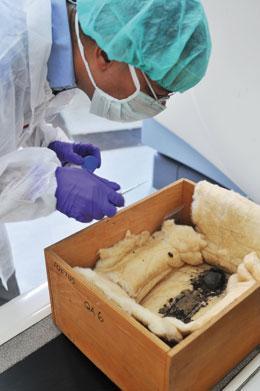Part- 2
Bones of contention
The Tutankhamun team carried out many controls, including replication of the tests by different teams in the two labs and comparing the mummy DNA fingerprints with those of the research team to cross-check for contamination. Zink and Pusch add that the samples were taken from within the mummies' bones where, they say, contaminating DNA should not have reached.
Zink and Pusch think that the mummification process protected the DNA from degrading in the hot tomb by removing water, which is required for the main mechanism of DNA decay, called depurination. Egyptian embalmers dried bodies with natron, a naturally occurring mixture of salts, immediately after death. "The Egyptians really knew how to preserve a body," says Zink. "They got rid of the water very fast." Tutankhamun was also smothered with embalming and anointing materials, thought to contain ingredients such as bitumen, plant oils and beeswax. The mixture had soaked deep into his bones, staining them black, and Pusch believes it gave the DNA additional protection from the damaging effects of water.
"There are a number of things right about the paper," says David Lambert, an ancient-DNA researcher and evolutionary biologist at Griffith University in Nathan, Queensland. Lambert points out that the Tutankhamun team was not able to amplify Y-chromosome markers from the female mummies, which argues against contamination from modern archaeologists, who are generally male. In unpublished work, he says he has amplified DNA from mummified ibises, a sacred bird in ancient Egypt. "We're confident that traditional PCR methods work with some of the material that we've got," he says.

Tiny bodies buried with Tutankhamun are thought to be his stillborn children.B. IVERSON & B. QUILICI
Sceptics, however, doubt that there was sufficient DNA left in Tutankhamun for the result to be real. They say that a mummified body would soon soak up any moisture available in the atmosphere, especially into its porous bones. When British archaeologist Howard Carter first opened Tutankhamun's coffins in 1925, he reported that they had been damaged by humidity. But it is difficult for anyone else to replicate the DNA work without permission to access the samples.
The Tutankhamun study has left the field more divided than ever, with clear frustration on both sides. "I don't understand people's harshness," Pusch says. "This is pioneering work." He and Zink say that they are sequencing DNA from the mitochondria and Y chromosomes of the mummies, and plan to publish these results this year.
But now, after years of conflict, strides in sequencing technology are changing the game. The newest techniques can read much shorter fragments — easily down to the 30 base pairs that might be found in a 2,000-year-old Egyptian mummy. "That pushes the [DNA] survival time a long way back," says Gilbert. "Things that we wrote off in the past, we can now get genomes on." And, crucially, the speed of the techniques makes it much easier to sequence a sample multiple times and to rule out contamination by checking for patterns of damage characteristic of ancient DNA.
Last year, these techniques enabled Willerslev, Gilbert and their colleagues to publish the full genome sequence of a palaeo-Eskimo from Greenland that is some 4,000 years old9. Within weeks, teams led by Pääbo published the genome of a 38,000-year-old Neanderthal10 and a previously unknown hominin from southern Siberia11. Meanwhile Zink's team is on the brink of publishing the genome of Ötzi the Iceman.
All these specimens were preserved in the cold — but Willerslev is already using next-generation techniques to extract DNA from various South American mummies, some of which have been preserved in warmer conditions. "Some are definitely working," he says. But, he adds, he is finding tremendous variability in whether samples yield DNA — a possible reason why Egyptian mummies have yielded such conflicting results. With the cost of sequencing falling sharply, researchers are lining up to try the techniques on Egyptian mummies.
Zink and Pusch are now negotiating the complex political path towards using next-generation techniques on Tutankhamun and his kin. "We would love to do this," says Zink. "It would absolutely make sense. The problem is to do it in Egypt." With no samples allowed out of the country, they would have to take the sequencing machines to Cairo, an expensive proposition. And there is concern, says Zink, that such work might yield politically sensitive information about the genetic origin of the pharaohs, and whether any of their descendants are alive today. "This goes right to their history."
Still, Zink is optimistic that next-generation sequencing will help to bring the fractured field back together. "I think it is really time to bring together the different sides and stop arguing about each other's work," he says. "With next-generation sequencing, people can't just say 'I don't like it'. People have to discuss the work based on the data themselves." Willerslev agrees, offering a rare olive branch. "I think we will find that the believers have been too uncritical," he says. "But the sceptics have probably been too conservative."
Jo Marchant is author of Decoding the Heavens: Solving the Mystery of the World's First Computer.
- References
- Hawass, Z. et al. J. Am. Med. Assoc. 303, 638-647 (2010).
- Pääbo, S. Nature 314, 644-645 (1985).
- Woodward, S. R., Weyand, N. J. & Bunnell, M. Science 266, 1229-1232 (1994).
- Cooper, A. & Poinar, H. Science 289, 1139 (2000).
- Krings, M. et al. Am. J. Hum. Genet. 64, 1166-1176 (1999).
- Marota, I., Basile, C., Ubaldi, M. & Rollo, F. Am. J. Phys. Anthropol. 117, 310-318 (2002).
- Donoghue, H. D. et al. Proc. R. Soc. B 277, 51-56 (2010).
- Lorenzen, E. D. & Willerslev, E. J. Am. Med. Assoc. 303, 2471 (2010).
- Rasmussen, M. et al. Nature 463, 757-762 (2010).
- Green, R. E. et al. Science 328, 710-722 (2010).
- Reich, D. et al. Nature 468, 1053-1060 (2010).